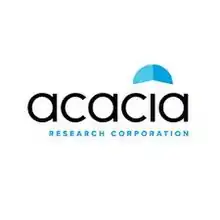Acacia Research
Acacia Research Corporation is a publicly traded American company based in New York City. Acacia partners with patent owners such as inventors and universities to license patents that are infringed. Roughly 95% of the company's business involves licensing infringed patents on behalf of patent owners to corporations through patent litigation.[4][5][6][7][8]
 | |
| Type | Public |
|---|---|
| Nasdaq: ACTG | |
| Industry | Patent Licensing & Monetization |
| Founded | 1993[1] |
| Founder | Paul Ryan |
| Headquarters | New York City, US[2] |
Key people | |
| Revenue | |
| Total assets | |
| Total equity | |
Number of employees | 287 (December 2021)[2] |
| Subsidiaries | Acacia Research Group LLC |
| Website | acaciaresearch |
Acacia was incorporated in California[9] in 1993 and is based in New York City.[10] The company was consisted of two divisions: Acacia Technologies and CombiMatrix Group.[9] The former covers the development, acquisition, licensing and enforcement of patented technologies.[9] It creates a subsidiary company that acts as a special purpose entity for each set of patents that it enforces. The patent owner assigns the infringed patents to the subsidiary and the subsidiary then licenses the patents to companies who are infringing. Acacia and the patent owner split any revenues generated from licensing the patents on a 50/50 basis.[11][12][6] Acacia's second division, CombiMatrix, constituted its life sciences business.[9] This division, which Acacia held from 2002 until 2007, operated as a subsidiary.[13][14] Invitae acquired CombiMatrix in 2017.[15]
Since the year 2000, Acacia has generated $1.4 billion in revenue from licensing patents and has paid out more than $731 million to inventors and other patent owners.[16][17] The company has formed 233 known subsidiaries and has litigated 1,412 cases, four of which were not through a subsidiary.[18]
References
- Acacia Research Corporation Form 10-K, received February 26, 2010,
- "Acacia Research Corporation 2021 Annual Report (Form 10-K)". U.S. Securities and Exchange Commission. 31 March 2022.
- "Acacia Research Corp Share Price: ACTG (Acacia Research Corp) Stock Price Today & Updates | INDmoney".
- Los Angeles Times
- USPTO Assignment Database - Acacia Patent Acquisition Corp
- USPTO Assignment Database - Acacia Research Group
- Acacia Technologies - Why work with Acacia?
- "Acacia Research Corporation 10-K Annual Report". www.sec.gov.
- "Acacia Research Corporation". Security and Exchange Commission. Retrieved 2022-07-19.
- "Acacia Research Corporation (ACTG) Company Profile & Facts - Yahoo Finance". finance.yahoo.com. Retrieved 2022-07-19.
- Los Angeles Times
- Acacia Technologies - Why work with Acacia?
- Anand, Geeta (2001-07-03). "Roche, CombiMatrix to Develop Genetics-Based Laboratory Tools". WSJ.com. Archived from the original on 2021-01-30. Retrieved 2021-01-30.
- "Form 10-K". SEC.gov. Retrieved 2021-01-30.
- Pedersen, Amanda (2017-08-01). "Invitae is Going After Prenatal Screening in a Big Way". MDDIonline.com. Archived from the original on 2021-01-30.
- Acacia Research: Overview
- SEC.gov Acacia Research 2018 10-Q
- RPX Corporation - Acacia Research